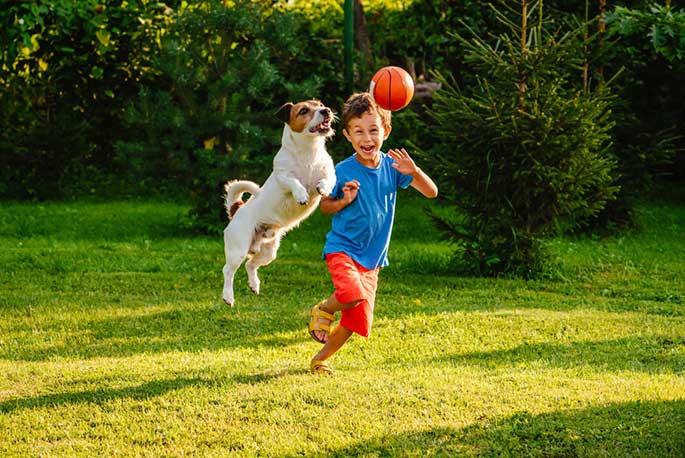
For some families, pets can be a powerful tool. They have the potential to teach your child the value of companionship, encourage physical activity and help your child learn essential life skills. Let’s take a closer look at the ways a pet can be good for your child, as well as a few things you should consider before taking the plunge.
How Children Benefit From Owning a Pet
There are so many positive side effects of pet ownership. Pets have a way of bringing families closer together and adding joy to everyone’s lives. Ask anyone who grew up with a pet, and they will more than likely tell you what a positive experience it was.
There Is No Friend Like a Pet
A pet can provide your child with a level of companionship that they don’t get with a parent, sibling or caretaker. Many children learn to express themselves more freely — without fear of judgment — by spending time with their pets. As your child learns to depend on their dog or cat, they are learning what it means to be a good friend. Additionally, a pet can help fill a void in your child’s life if they are struggling to adapt to a new neighbourhood, school or living situation.
Playtime Encourages Physical Activity
Some pets — especially dogs — can encourage your child to be physically active and spend more time outdoors. For parents struggling to pull your child away from the television or cellphone, pet ownership can be a great way to handle this. Once a day, plan a time for you and your child to set aside and play with your new pet. If its a dog, this could be a game of tug-of-war, fetch or going for a long walk in the park. You can also encourage your child to be adventurous and bring your dog along on hikes or day trips to new places. Both your child and your pet will benefit from the time spent playing together.
A Pet Can Teach Life Skills
Pets and pet ownership can be an excellent way to teach your child important life skills that they will continue to use and develop. Some of those skills include:
- Responsibility: Taking care of a pet often means taking them for walks, filling food and water bowls, cleaning cages or litter boxes and cleaning up after messes or accidents. As you teach your child how to handle these new responsibilities, they’re learning how to provide basic care for another living thing. Day-to-day care helps your child develop and adapt to new routines. Your child will also come to learn that sometimes, caring for others might require putting their needs above you child’s own.
- Stress management: Pets provide an emotional outlet for your child. They can be a quiet friend, a welcomed distraction or just a reassuring presence when they are going through difficult times. Numerous studies have found that there are emotional and behavioral benefits to pet ownership, including reduced anxiety and depression, higher self-esteem, better decision-making skills and more.
- Compassion: The world can always use a little more kindness and compassion — and pets are one way to instill values of love, care and empathy in your child.
What You Should Consider Before Bringing a Pet Into Your Home
The benefits of pet ownership are clear, but that doesn’t mean it is right for everyone. There are a few factors you and your family should take into careful consideration before heading to the local shelter or pet store.
If you are a family that travels a lot. A small low maintenance pet like a guinea pig is a good idea, pick up a guinea pig carrier and travel hut so you can bring them along on your next vacation.
The Cost
Pets require more than your love and affection — they also need food, regular and emergency veterinarian care, occasional boarding, grooming and more. Some dogs and cats can even cause costly damages to your home, furniture or belongings. Over time, these costs add up. On one hand, this can be an additional lesson for your child. They can learn the importance of thoroughly caring for an animal, as well as what it looks like to set aside money for different needs. However, if you are not financially prepared to care for a pet, it is in everyone’s best interest if you wait until you are more comfortable.
Constant Care
All pets, regardless of species, require constant care. Before you choose to bring a pet into your home, consider what kind of lifestyle you currently have. Is there someone at home during the day who would walk and feed a pet? Keep in mind not all caretakers are willing to care for a pet on top of their childcare duties.
Does your family travel a lot? Do you have enough space in your home for a pet? You also need to consider what will happen once the novelty of a new pet wears off for your child. Once the excitement of a new pet has passed, they may stop taking an active role in caring for it. When this happens, it is important that you still encourage your child to take on these responsibilities.
Allergies
Even if you are sure you want to bring a new pet home, you might still have a few obstacles to overcome. Allergies, for example, are a common reason families choose not to adopt a pet. Symptoms of pet allergies can include:
- Frequent sneezing or coughing
- Itchy, watery or red eyes
- Runny or congested nose
- Unexplained swelling or discolouration
If you, your child or anyone else living in your home has known allergies, a dog or cat may not be the best fit. Instead, consider something that does not shed, like a fish, bird, reptile or hamster.
Once you have carefully weighed your options and understand the costs of pet ownership, you may decide that pet ownership is not right for your family right now — and that’s okay! There are numerous other ways to teach your child responsibility and other valuable life skills. If you do decide to adopt a pet, understand that while it is a lot of hard work, some of your child’s best memories will be made with their new friend.



